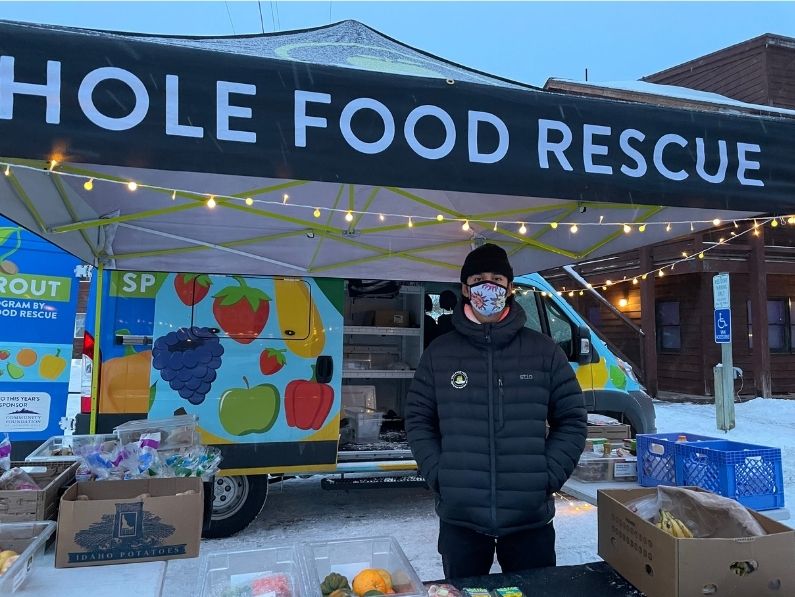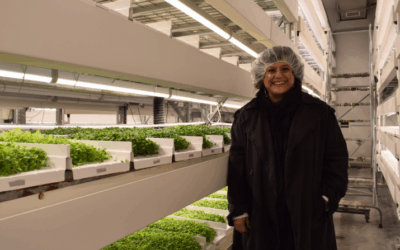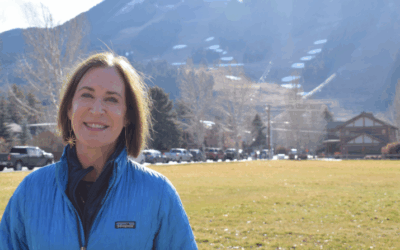It’s a Monday evening at the Timbers Apartments, and people are gathered outside a brightly colored van. Tables are laid out with ripe red tomatoes, bundles of bananas, as well as blueberries, greens, yogurts, and bread and treats from Persephone Bakery. A tall man stands beneath a string of lights welcoming visitors in English and Spanish.
This is Hole Food Rescue’s No Cost Grocery Program. Hole Food Rescue was founded several years ago with a mission to collect surplus food from grocery stores and distribute it to social service organizations. The program keeps tons of waste out of the landfill and aids food security for community members.
Single mom Susan – who did not give her last name – relies on both of the no-cost programs that Hole Food Rescue does each week, the other one being at the Blair Place Apartments on Wednesdays.
“I have two small children so anything helps to fill up the fridge and not empty the wallet,” Susan said.
People from all walks of life visit the table. Latina moms. Snowboard instructors. Bartenders. A young dad from East Jackson stops by to grab a meal for his family. He says money is tight and he has two small kids to feed.
According to the Wyoming Hunger Initiative, one in six children in Wyoming struggle with food insecurity. A 2017 study by the national organization Feeding America showed that 11.7 percent of kids in Teton County were food insecure. That translated to 520 individual kids.
Rates of food insecurity generally have skyrocketed nationally during the pandemic. A report by the Food Research and Action Center showed a jump from four percent of Americans experiencing hunger before the pandemic to 11 percent now.
Hole Food Rescue Director of Programs Hannah Cooley says she has witnessed an increase in newcomers to the food program.
“Many people have said that they have never received food assistance before, and this is the first time they’ve been doing it,” Cooley said.
A Different Model
The tall guy staffing the table is Ivan Jimenez, the Community Coordinator for Hole Food Rescue. He says every week he receives baked goods made by his repeat customers. This Monday, a woman named Hilaria brought him a bright red dessert.
“Hilaria is there every week and she is very grateful, and so for the holidays she wanted to make me a cake, but she knows I’m vegan so she made me a Jell-O Cake with fruit.”
This is the kind of community Hole Food Rescue hopes to foster.
“Our conversation is, ‘Thank you. You are helping this issue of food waste and if it wasn’t for you all this food would be thrown away,’” Cooley said.
Jimenez said the no-cost grocery program distributes 3500 pounds of food to about 100 shoppers per week. While the neighborly vibe may be cheery, the underlying issue of hunger is grim. Studies show that families in Teton County are struggling with food insecurity. Pre-COVID, it was estimated that 11.7 percent of kids in Teton County were food insecure.
Food Research and Action Center estimates that COVID has affected different groups in disproportionate ways. Latin-X people are 27 percent of those experiencing hunger today. Women, too, are more likely to be hungry, as they have lost their jobs at higher rates than men.
Ash Hermanowski has worked in food access for years, including a stint with Hole Food Rescue as well as her current job at the Jackson Hole Cupboard. She says she has been struck by how many people in Jackson are in need of food assistance.
“What I’ve seen a lot of, and especially since COVID, is how many people are one or two paychecks away from needing rental assistance or food assistance and that is so much more people than we would think,” she said.
Hermanowski says that no-cost food distribution is essential in a country that can’t guarantee that everyone will have enough to eat.
“To me, this is the short term work, this is the Band-Aid, this is the emergency filling in the gaps for people,” she said. “But that should never be normal. So if I’m not advocating while I’m also doing this work it can feel like I’m just perpetuating that this is okay. The system is failing us and we can acknowledge that.”
As a board member for the affordable housing advocacy group Shelter JH, Hermanowski says housing and food security are interlinked.
“You look at food, you’re looking at housing, you’re looking at wages, you’re looking at climate change. All these things are connected.”
Hermanowski encourages people who care about food insecurity to advocate for affordable housing and livable wages. Changing the system, she says, is the way to eradicate hunger.






